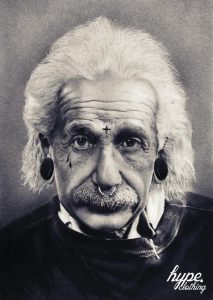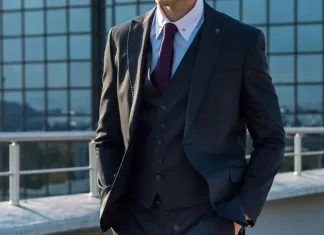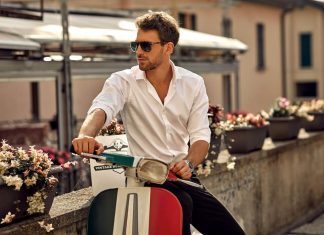
First Published: 10th September 2021, written by Chloé Safilo | Last Updated on 6th January 2024 | Reviewed and Edited by Chloe Safilo
Who started Hype Clothing?
Back in 2011 friends Liam Greene and Aidy Lennox won a Printing Firms Facebook competition by defacing a picture of Albert Einstein to reimagine how he might have looked in modern times wearing men’s jewellery. The prize was a print run of the t-shirt, and they sold all 150 for £10 each in days.

The young graphic designers had spent years freelancing creating designs for music flyers, and the opportunity presenting itself was too good to miss to try and crack the youth clothing market. They had an advantage being the same age as their target audience so they knew what was popular and how to sell it. Teenagers wanted to be both individuals and conform, and Hype was ready to take that gap in the market.
They had ideas, bucket loads of them. So they took a custom-designed lighter with a message to “get your own fucking lighter”, and some t-shirt designs and hit the streets of Leicester to speak to wholesalers and retailers. Desperate to get into the fashion industry, they joined forces with Bav Samani who loved their ideas to manage Production.
He set things up with Vinay Patel of Thread Press LTD, who had the industry connections to get it moving. They shook hands on it and Hype was born. They started by importing stock garments from Dubai, Pakistan and China and used local printers and dye houses.
Hype or Justhype?
While I like to romanticise that they sat in a smoky room and decided on the street style fashion brand name something like:
“How about Hype”
“Hype Clothing?”
“Just Hype.”
“Cool”
But it’s more likely that it was a simple marketing decision. The website was not set up until 2012 and it could just have been hypeclothing.com and hype.com were already taken. They were already known as Hype Clothing on Tumblr, the social media platform of choice back then, so sometimes a creative license is needed to get the website you want.
They are also not to be confused with Hypebeast, which came later (although the word was around beforehand meaning someone who loves trends)
Who Owns Hype?
Just Hype LTD was set up as a company in 2012 by Bav Samani and Vinay Manu, and its initial major shareholder was Noir investment (with equal squares for the trio. They also set up Toatee Ltd, a multi-disciplined agency based in the UK focusing on brand development, product sourcing, manufacturing, design, distribution, operations, e-commerce & sales.
Using Hype as a showbrand, they took on other brands for sampling, manufacturing, consulting and executing new brand strategies. Currently, it appears that the only shareholder is Bav Samani.

The growth of Hype
After starting off with a small office space in Leicester, the brand rapid growth has seen global representation by global superstars such as Jay-Z, 50 Cent, Little Mix, Tom Hardy, Cara Delevigne, Ellie Goulding, Gary Beadle, Idris Elba, One Direction, Oliver Proudlock, Paloma Faith, Rudimental, Rizzle Kicks, Tinchy Stryder, Tinie Tempah and The Wanted.
Hype clothing is very popular with 14-25-year-olds who have a rebellious edge striving for a sense of individuality. Spring boarded by social media, they have kept things current with Music and festivals and popular culture.
The key to their success though was social media. At the time Facebook, Instagram and Twitter were at the peak for their target age group to be engaged followers. They were able to build digital hysteria with their limited run drops and launches. But more importantly, they used that route to customers to get direct feedback on design direction. They posted design ideas, and if it got over 500 likes they’d print it.
The brand has really come into its own with Fashion Collabs to reach new, wider audiences with their designs. Collaborations with childhood favourites like Disney, Spongebob Squarepants, Lego, Teenage Mutant Ninja Turtles, Playstation, Toy Story, The Simpsons, Pokemon, Coca-Cola, Star Wars, Jurassic Park and Barbie have seen great commercial success. An upcoming E.T Collab will attract young and old with its retro feel.
What is Hype Clothing known for?
Back when starting they were more alternative and aimed at the metal/punk crowd, skateboarders and streetwear hipsters. Often the designs were bright, loud and garish. And they were snapped up in record time.
Aside from their famed Hype customer service, they are probably best known for their bags, backpacks and lunch boxes which have adorned schoolkids for years. The brand even produces pencil cases, laptop bags and phone cases, camping stools and water bottles.
The complete range includes menswear, womenswear and kidswear. Covering jackets, bucket hats, beanies, polo shirts, holdalls, coach jackets, t-shirts, sweatshirts, shirts, suits and blazers, snap-back caps, joggers, backpacks, flip flops, bum bags, hoodies, 5-panel caps, vests, jeans, footwear, dresses, parkas, cagoules, chinos, shorts, coats, bobble hats, and skirts.
Back to School essentials
Hype is super popular with school kids, and each autumn there are many demands on parents to get the latest gear. Bags are always in demand, but it seems the Hype metal water bottle is the on-trend must-have for 2022.
Are Hype bags good quality?
Yes, customer reviews state they are of good quality and hard-wearing, with padded shoulders. Something that does seem to come up a bit frequently is the quality of the zips, but it’s unlikely this is unique to Hype.
Hype bags are made from 100% polyester so would be rain repellent rather than waterproof.
Alternatives for those who don’t like bright colours are Vans, Adidas, Nike, Animal, Superdry, North Face, Hot Tuna, Under Amour and Eastpak.
Is Hype a good brand?
Yes, overall they have great reviews. At the time of writing, there are a few people disgruntled with customer services and packing errors but every brand will have a percentage of issues. When you are shifting a high volume of orders that just means a higher amount of problems occur. Also, people are more inclined to leave a bad review than a good one.
It’s worth pointing out how brands manage their customer service. If high volume it likely uses a ticketing system, which means once answered it drops to the bottom of the queue. So potentially you might get a response once every 24 hours, which people who expect instant answers are not happy about.
I personally always put the quality of the clothes as the number one priority, and the Hype Brand clothing and bags are popular for a reason. Kids do put a lot of stock in street cred and Hype are still cool in 2022.
Black Friday Deals
Everyone loves a bargain and the Hype Blackout November has already started.
How does Hype fit?
Hype clothes comes up small so is not true to size, and they do not do free returns so is something to bear in mind when ordering online. They have a comprehensive size guide which is worth consulting before you purchase.
Where can I buy Hype Clothing?
Hype has a flagship London store and also one in Truro, and of course their online shop. The brand is also stocked in major retailers like Next, Amazon, Footaslyum, Sports Direct, DV8, Zalando, House of Fraser, Very, Asos, Topman and many more.
What is the Hype Logo?
The Hype clothing Logo is a simplistic script logo with a laurel circle, but there are many variations, but always the script style. Note the hype has no capital and a full stop.
Just Hype are not to be confused with US brand Only Hype.

Commitment to sustainability
In 2021 Hype partnered with environmental group Ecologi in an attempt to be more sustainable and reduce global greenhouse emissions in their production by planting a tree with each order placed.
The brand aims to be fully sustainable by 2022, and also ensure their garment production is made in ethical factories.
What is Hype?
Hype is a social marketing strategy to build demand for a product through social media or publicity, usually for limited edition items, or at least giving that impression to promote FOMO – fear of missing out. In general, hype relates to extravagant claims, likely coming from the word hyperbole which is exaggerated statements like “this is the best water bottle ever. Fact.”
It’s often used in marketing for luxury goods, but more recently has been adopted by fast fashion and streetwear brands. Supreme not only build hype on products about to launch citing limited numbers but also have collaborations with luxury fashion brands to justify premium prices.















































